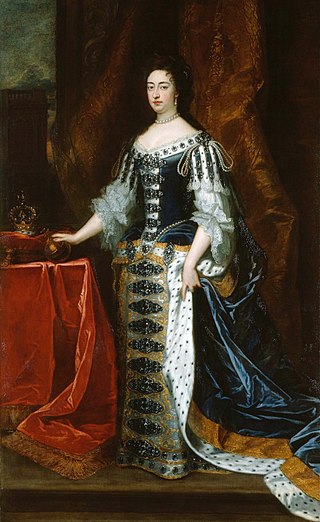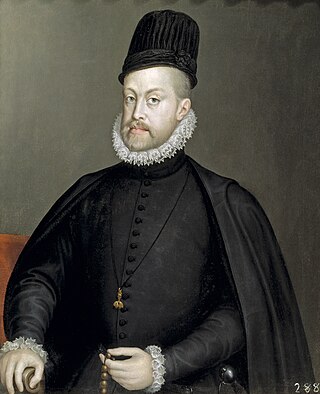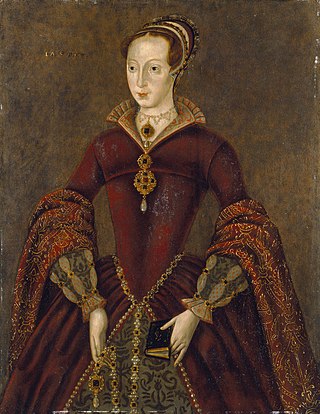
Elizabeth I was Queen of England and Ireland from 17 November 1558 until her death in 1603. Elizabeth was the last monarch of the House of Tudor and is sometimes referred to as the "Virgin Queen".

Henry VII was King of England and Lord of Ireland from his seizure of the crown on 22 August 1485 until his death in 1509. He was the first monarch of the House of Tudor.

Henry VIII was King of England from 22 April 1509 until his death in 1547. Henry is best known for his six marriages, and his efforts to have his first marriage annulled. His disagreement with Pope Clement VII about such an annulment led Henry to initiate the English Reformation, separating the Church of England from papal authority. He appointed himself Supreme Head of the Church of England and dissolved convents and monasteries, for which he was excommunicated by the pope.

Mary II was Queen of England, Scotland, and Ireland, co-reigning with her husband, William III & II, from 1689 until her death in 1694. She was also Princess of Orange following her marriage on 4 November 1677.

Mary I, also known as Mary Tudor, and as "Bloody Mary" by her Protestant opponents, was Queen of England and Ireland from July 1553 and Queen of Spain as the wife of King Philip II from January 1556 until her death in 1558. She is best known for her vigorous attempt to reverse the English Reformation, which had begun during the reign of her father, King Henry VIII. Her attempt to restore to the Church the property confiscated in the previous two reigns was largely thwarted by Parliament, but during her five-year reign, Mary had over 280 religious dissenters burned at the stake in the Marian persecutions.

The House of Tudor was a dynasty of largely Welsh and English origin that held the English throne from 1485 to 1603. They descended from the Tudors of Penmynydd and Catherine of Valois. The Tudor monarchs ruled the Kingdom of England and its realms, including their ancestral Wales and the Lordship of Ireland for 118 years with five monarchs: Henry VII, Henry VIII, Edward VI, Mary I and Elizabeth I. The Tudors succeeded the House of Plantagenet as rulers of the Kingdom of England, and were succeeded by the House of Stuart. The first Tudor monarch, Henry VII of England, descended through his mother from a legitimised branch of the English royal House of Lancaster, a cadet house of the Plantagenets. The Tudor family rose to power and started the Tudor period in the wake of the Wars of the Roses (1455–1487), which left the main House of Lancaster extinct in the male line.

Philip II, also known as Philip the Prudent, was King of Spain from 1556, King of Portugal from 1580, and King of Naples and Sicily from 1554 until his death in 1598. He was also jure uxoris King of England and Ireland from his marriage to Queen Mary I in 1554 until her death in 1558. He was also Duke of Milan from 1540. From 1555, he was Lord of the Seventeen Provinces of the Netherlands.

Lord Guildford Dudley was an English nobleman who was married to Lady Jane Grey. She occupied the English throne from 10 July until 19 July 1553, having been declared the heir of King Edward VI. Guildford Dudley had a humanist education and married Jane in a magnificent celebration about six weeks before the King's death. After Guildford's father, the Duke of Northumberland, had engineered Jane's accession, Jane and Guildford spent her brief rule residing in the Tower of London. They were still in the Tower when their regime collapsed and remained there in different quarters as prisoners. They were condemned to death for high treason in November 1553. Queen Mary I was inclined to spare their lives, but Thomas Wyatt's rebellion against Mary's plans to marry Philip of Spain led to the young couple's execution, a measure that was widely seen as unduly harsh.
A prince consort is the husband of a monarch who is not a monarch in his own right. In recognition of his status, a prince consort may be given a formal title, such as prince. Most monarchies do not allow the husband of a queen regnant to be titled as a king because it is perceived as a higher title than queen, however, some monarchies use the title of king consort for the role.

Thomas Howard, 3rd Duke of Norfolk, was a prominent English politician and nobleman of the Tudor era. He was an uncle of two of the wives of King Henry VIII, Anne Boleyn and Catherine Howard, both of whom were beheaded, and played a major role in the machinations affecting these royal marriages. After falling from favour in 1546, he was stripped of his dukedom and imprisoned in the Tower of London, avoiding execution when Henry VIII died on 28 January 1547.

Succession to the British throne is determined by descent, sex, legitimacy, and religion. Under common law, the Crown is inherited by a sovereign's children or by a childless sovereign's nearest collateral line. The Bill of Rights 1689 and the Act of Settlement 1701 restrict succession to the throne to the legitimate Protestant descendants of Sophia of Hanover who are in "communion with the Church of England". Spouses of Catholics were disqualified from 1689 until the law was amended in 2015. Protestant descendants of those excluded for being Roman Catholics are eligible.

Wyatt's Rebellion was a limited and unsuccessful uprising in England in early 1554 led by four men, one of whom was Sir Thomas Wyatt. It was given its name by the solicitor at Wyatt's arraignment who stated, for the record, that "this shall be ever called Wyat's Rebellion". The rebellion arose out of concern over Queen Mary I's determination to marry a foreigner, Philip II, Prince of Spain, and to return England to Catholicism and papal authority. The uprising failed, with consequences for the rebels that ranged from death to forgiveness.

Lady Jane Grey, also known as Lady Jane Dudley after her marriage and as the "Nine Days' Queen", was an English noblewoman who claimed the throne of England and Ireland from 10 to 19 July 1553.
Jure uxoris describes a title of nobility used by a man because his wife holds the office or title suo jure. Similarly, the husband of an heiress could become the legal possessor of her lands. For example, married women in England and Wales were legally incapable of owning real estate until the Married Women's Property Act 1882.
Lady Elizabeth FitzGerald, Countess of Kildare, was an Anglo-Irish noblewoman, the second wife of Gerald FitzGerald, 9th Earl of Kildare. Her father was Thomas Grey, 1st Marquess of Dorset. Her mother, Cecily, was the wealthiest heiress in England after succeeding to the title of suo jure 7th Baroness Harington of Aldingham and then the title of suo jure 2nd Baroness Bonville.
The Reformation in Ireland was a movement for the reform of religious life and institutions that was introduced into Ireland by the English administration at the behest of King Henry VIII of England. His desire for an annulment of his marriage was known as the King's Great Matter. Ultimately Pope Clement VII refused the petition; consequently, in order to give legal effect to his wishes, it became necessary for the King to assert his lordship over the Catholic Church in his realm. In passing the Acts of Supremacy in 1534, the English Parliament confirmed the King's supremacy over the Church in the Kingdom of England. This challenge to Papal supremacy resulted in a breach with the Catholic Church. By 1541, the Irish Parliament had agreed to the change in status of the country from that of a Lordship to that of Kingdom of Ireland.

Mary I of England (1516–1558) and Philip of Spain married at Winchester Cathedral on Wednesday 25 July 1554.













